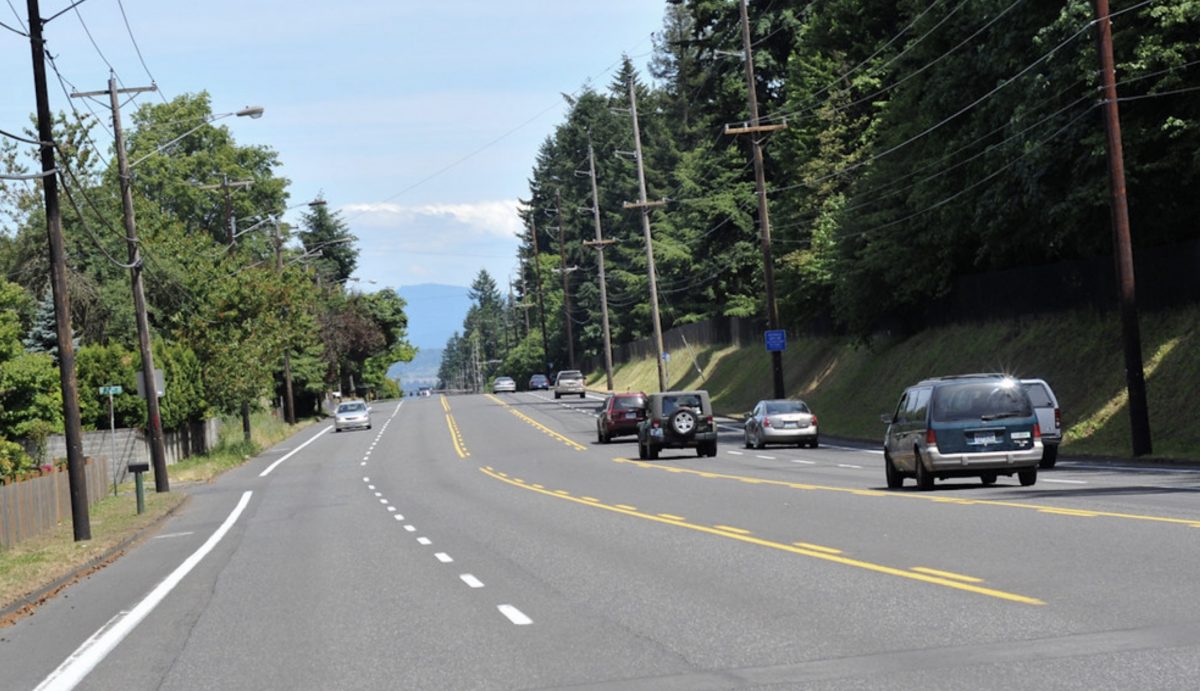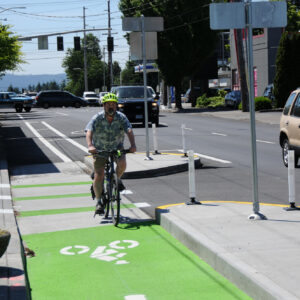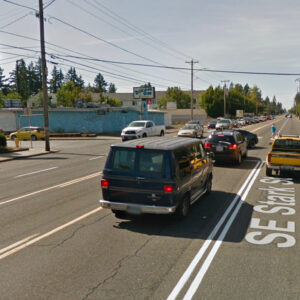
(Photos: Jonathan Maus/BikePortland)
After years of red flags and community outcry, Portland’s transportation bureau announced Friday they will finally break ground on updates to Northeast Halsey Street between 112th and 162nd avenues (the Gresham border). PBOT also announced that effective today (Monday, September 13) they’ll implement a new speed limit on this this two-mile stretch of Halsey. The new speed limit is 30 mph, down from the current limit of 35 mph between 11th and 137th and 40 mph from 137th to the city limits.
In their statement, PBOT called the speed reduction move “decisive”, an “emergency”, and a “rare, dramatic step in the city’s effort to achieve Vision Zero.” PBOT Director Chris Warner used Oregon Revised Statute (ORS) 810.180 (9) to make the change without waiting for Oregon Department of Transportation approval. Halsey is on PBOT’s high crash corridor list which means it has a higher than average incidence of fatal and serious injury collisions. Four people have been killed while using this section of Halsey since 2019. In 2020, a two-car collision resulted in the deaths of Cornelius Nevills and Gabrielle Greenwood and two other serious injuries. 11 days later, Aaron Gray was walking on Halsey when he was hit and left to die in the road by a car driver who didn’t even stop.

This section of Halsey begins just east of where PBOT and their partners invested over $5 million in new protected bike lanes and other safety-related updates in 2019. It has an all too familiar cross-section of a wide center turn lane and two wide general lanes next to substandard, unprotected bike lanes. In 2016, PBOT received $1 million from the city budget for new sidewalks and other safety updates. The need for a safer design of Halsey has been called out by the community for many years and was recommended for updates in the East Portland in Motion Plan in 2011.
In a city council proclamation in December 2016, PBOT called out the “very high rate of traffic crashes” on outer Halsey and added, “It is urgent that the City take steps now to respond to the community’s request for increased funding for education and outreach programs on Outer Division, and for two other high crash corridors, Outer Halsey and Outer Glisan.”
Advertisement

Now set to break ground in the coming weeks, PBOT’s Outer Halsey Safety Project will build two new crossings, add street lights, upgrade curb ramps and build about a mile of new sidewalks. The new crossings will be at 119th and 128th and will include concrete median islands and rapid flashing beacons. To pay for the project, PBOT will use funds from the $450,000 pot of general fund revenue Commissioner Jo Ann Hardesty successfully lobbied council for back in June.
The new 30 mph speed will be in place for 120 days. PBOT will aim to have their safety improvements completed before then and adjust driving behaviors enough to make the reduction permanent. Since ODOT considers prevailing speeds in their assessment of speed limits, PBOT will often combine reduction requests with infrastructure changes intended to slow people down.
PBOT has used this emergency authority several times since early 2017 when tragedies and trauma on Southeast Division, coupled with strategic activism created so much pressure that PBOT and city council were forced to act. PBOT also invoked this statute to lower speed limits on Southeast Stark in 2018.
The big question is whether or not PBOT’s plans for Halsey will actually work. They’ve had some success reducing top-end speeding (10 mph or more over the limit) with this combination of lower speed limits and infrastructure tweaks. So far there’s been no mention of an enforcement strategy. Commissioner Hardesty is very supportive of radar camera enforcement and her budget amendment passed back in June specifically calls for the funds to be used on more cameras.
So far this year the Portland Police have tallied 47 traffic deaths, that’s 10 more than last year at this same date and it puts us on pace to reach a very grim total.
Asked by Willamette Week for a response to PBOT’s announcement about Halsey, Oregon Walks Executive Director said, “Northeast Halsey is designed like a drag strip, and this doesn’t change that… We’re not doing enough.”
— Jonathan Maus: (503) 706-8804, @jonathan_maus on Twitter and jonathan@bikeportland.org
— Get our headlines delivered to your inbox.
— Support this independent community media outlet with a one-time contribution or monthly subscription.






Thanks for reading.
BikePortland has served this community with independent community journalism since 2005. We rely on subscriptions from readers like you to survive. Your financial support is vital in keeping this valuable resource alive and well.
Please subscribe today to strengthen and expand our work.
Zero enforcement. Zero compliance.
A new transportation planning term under municipal time: It’s an “emergency”, so it took only ten years to get started.
those bike lanes are criminally bad design. No wonder there are no bikes in the lane. If we want people to bike on fast roads, need more distance from vehicles
LOL! More speed limit reductions without a plan for enforcement. Won’t make a lick of difference.
I don’t have the data to prove it but I feel like this tactic makes riding a bike or being a pedestrian MORE dangerous than before. I know from personal experience that the reduced speed on N Willamette has just made even more motorist use the gutter lanes as auxiliary driving lanes. I wont even bike down N Willamette anymore.
Speed limit changes are the cheapest and most useless option, which is why PBOT is employing them, but they really don’t accomplish much if anything. I have seen some traffic enforcement on N Willamette for the first time in two years so maybe that’s a trend.
Physical infrastructure changes are the only things that actually slow motorist down.
This may sound like hyperbole, but given that motorist have demonstrated a commitment – a commitment – to breaking the law, causing harm and behaving dangerously, I simply don’t think they deserve freedom of choice any longer. Take the keys away.
I’m sure they meant that statement to add gravitas, but it really has quite the opposite affect. This is what they think dramatic action looks like?
LOL. When will PBOT realize that lowering the speed limit without concomitant enforcement does absolutely nothing.
The two new crossings will lower the average distance between marked crossings from 3,366 feet to 2,200 feet. Which is still criminal.
PBOT’s action on the speed limit follows ODOT’s 5/29/19 rejection of a 7/11/18 request by PBOT to reduce the speed from 35 MPH to 30 west of 137th, and ODOT’s approval of watered down -5 MPH (to 40 MPH) instead of the requested -10 MPH east of 137th.
Traffic volumes are not high enough for the engineers to reject reconfiguring lanes on this stretch. On this stretch it’s people (mostly from Gresham) who want to drive fast through the neighborhood vs safety and comfort of everyone else. Halsey goes to 2 lanes a little over a mile to the east in any event.
There is virtually no reason to cross Halsey along the golf course fence between 138th and 148th. (I even live right in the middle of that stretch, and don’t find it cumbersome to cross to walk to Glendoveer.) Omitting that stretch, the marked crosswalks at 112th, 119, 122, 128, 132, and 137th make the average distance between crosswalks on that stretch 5 blocks (1/4 mile, about 1300 feet), so average distance to crosswalk is half that.
Now that the speed limits have been instituted, the great majority of traffic honors them, and Portland needs a few high-throughput streets with multiple lanes. Cutting down the number of lanes will not stop speeders in off hours.
Lowering speed limits is fine. But what about actually making people drive slower? There’s no recourse against speeders and there are a lot of speeders in PDX.